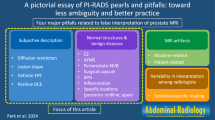Abstract
Radiologic–pathologic correlation of Prostate Imaging Reporting & Data System (PI-RADS) scores ensures local quality and offers opportunities to improve future iterations of the reporting system. Tracking positive predictive values of lesion-targeted biopsies helps provide generalizable population-level risks associated with each PI-RADS category and can highlight the sources of variation. While this process of formalized pathologic correlation is somewhat new to abdominal radiology, we are fortunate to have a model to follow which was developed by our colleagues in breast imaging. If the success and multi-national adoption of BI-RADS is an indicator, building a scoring system anchored on a histologic reference is an important step to ensuring diagnostic quality and reliability.
Similar content being viewed by others
References
Rosenkrantz AB, Hemingway J, Hughes DR, Duszak R Jr, Allen B Jr, Weinreb JC. Evolving Use of Prebiopsy Prostate Magnetic Resonance Imaging in the Medicare Population. J Urol. 2018;200(1):89-94.
Oberlin DT, Casalino DD, Miller FH, Meeks JJ. Dramatic increase in the utilization of multiparametric magnetic resonance imaging for detection and management of prostate cancer. Abdom Radiol (NY). 2017;42(4):1255-1258.
Turkbey B, Rosenkrantz AB, Haider MA, et al. Prostate Imaging Reporting and Data System Version 2.1: 2019 Update of Prostate Imaging Reporting and Data System Version 2. Eur Urol. 2019;76(3):340-351.
Burnside ES, Sickles EA, Bassett LW, et al. The ACR BI-RADS® Experience: Learning From History. Journal of the American College of Radiology. 2009;6(12):851-860. https://doi.org/10.1016/j.jacr.2009.07.023.
D’Orsi CJ, Sickles EA, Mendelson EB, Morris EA, et al. ACR BI-RADS® Atlas, Breast Imaging Reporting and Data System. American College of Radiology; 2013.
Westphalen AC, Margolis DJA, Rosenkrantz AB. The Director of Prostate Imaging: advancing care for prostate cancer patients. Abdom Radiol (NY). 2017;42(9):2358-2362.
Curci NE, Gartland P, Shankar PR, et al. Long-distance longitudinal prostate MRI quality assurance: from startup to 12 months. Abdom Radiol (NY). 2018;43(9):2505-2512.
Barkovich EJ, Shankar PR, Westphalen AC. A Systematic Review of the Existing Prostate Imaging Reporting and Data System Version 2 (PI-RADSv2) Literature and Subset Meta-Analysis of PI-RADSv2 Categories Stratified by Gleason Scores. AJR Am J Roentgenol. 2019;212(4):847-854.
Author information
Authors and Affiliations
Corresponding author
Additional information
Publisher's Note
Springer Nature remains neutral with regard to jurisdictional claims in published maps and institutional affiliations.
Rights and permissions
About this article
Cite this article
Shankar, P.R., Davenport, M.S. & Helvie, M.A. Prostate MRI and quality: lessons learned from breast imaging rad–path correlation. Abdom Radiol 45, 4028–4030 (2020). https://doi.org/10.1007/s00261-019-02343-2
Published:
Issue Date:
DOI: https://doi.org/10.1007/s00261-019-02343-2




